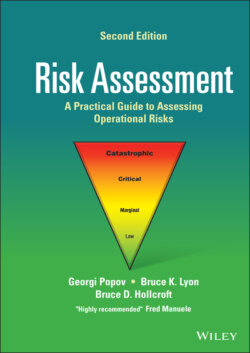Читать книгу Risk Assessment - Georgi Popov - Страница 49
References
Оглавление1 ANSI/ASSP Z10.0‐2019 (2019). Occupational Health and Safety Management Systems. Park Ridge, IL: American Society of Safety Professionals.
2 ANSI/ASSP Z590.3‐2011(R2016) (2016). Prevention through Design: Guidelines for Addressing Occupational Hazards and Risks in Design and Redesign Processes. Park Ridge, IL: American Society of Safety Professionals.
3 ANSI/ASSP Z690.1‐2011 (2011). Vocabulary for Risk Management. Park Ridge, IL: American Society of Safety Professionals.
4 ANSI/ASSP/ISO 31000‐2018 (2018). Risk Management. Park Ridge, IL: American Society of Safety Professionals.
5 ANSI/ASSP/ISO 31010‐2019 (2019). Risk Management – Risk Assessment. Park Ridge, IL: American Society of Safety Professionals.
6 ANSI/ASSP/ISO 45001‐2018 (2018). Occupational Health and Safety Management Systems – Requirements with Guidance for Use. Park Ridge, IL: American Society of Safety Professionals.
7 ANSI B11.0‐2020 (2020). Safety of Machinery. Houston, TX: B11 Standards, Inc.
8 ANSI B11.TR3‐2000 (2000). Risk Assessment and Risk Reduction – A Guide To Estimate, Evaluate, and Reduce Risks Associated with Machine Tools. The Association for Manufacturing Technology: McLean, VA.
9 Bank for International Settlement (2011). Principles for the Sound Management of Operational Risk. Basel, Switzerland: https://www.bis.org/publ/bcbs195.pdf (accessed 6 June 2021).
10 BS OHSAS 18001‐2007 (2007). Occupational Health and Safety Management Systems – Requirements. London, UK: British Standards Institution (BSI).
11 BusinessDictionary.com, 2015. (accessed 6 June 2021)http://www.businessdictionary.com/
12 Carlson, C.S. (2012). Effective FMEAs – Achieving Safe, Reliable, and Economical Products and Processes Using Failure Mode and Effects Analysis. Hoboken, NJ: Wiley.
13 EPA. Risk management programs for chemical accidental release prevention. https://www.epa.gov/rmp (accessed 6 June 2021)
14 Manuele, F.A. (2013). On the Practice of Safety. Hoboken, NJ: Wiley.
15 MIL‐STD‐882E (2012). Standard Practice for System Safety. Washington, DC: Department of Defense http://www.system‐safety.org/. Scroll down and click on MIL‐STD‐882E in the right hand column for a free copy.
16 NFPA 70E (2015). Standard for Electrical Safety in the Workplace, 2015e. National Fire Protection Association: Quincy, MA.
17 (1992). OSHA’s Rule for Process Safety Management of Highly Hazardous Chemicals, 1910.119. Washington, DC: Department of Labor, Occupational Safety and Health Administration.
18 OSHA 29 CFR 1910.134. Personal Protective Equipment, General Requirements. Washington, DC: Department of Labor, Occupational Safety and Health Administration.
19 OSH Act of 1970. Section 5, Duties, General Duty Clause. Washington, DC: Department of Labor, Occupational Safety and Health Administration.
20 OSHA Law & Regulations. https://www.osha.gov/laws‐regs/oshact/completeoshact 1970 (accessed 6 June 2021).
21 Rausand, M. (2011). Risk Assessment: Theory, Methods, and Applications. Hoboken, NJ: Wiley.
22 (1996). Risk Management Programs for Chemical Accidental Release Prevention, 40 CFR Part 68. Washington, DC: Environmental Protection Agency.
23 Stephans, R.A. (2004). System Safety for the 21st Century: The Updated and Revised Edition of System Safety 2000. Hoboken, NJ: Wiley.
24 The Institutes. Risk Management Principles and Practices, Quadrants of Risk: Hazard, Operational, Financial, and Strategic. http://www.theinstitutes.org/comet/programs/arm/assets/arm54‐chapter.pdf (accessed 18 March 2015).
25 U.S.NRC. ALARA. United States Nuclear Regulatory Commission Library. On‐line glossary last updated 9 March 2021. http://www.nrc.gov/reading‐rm/basic‐ref/glossary/alara.html (accessed 6 June 2021).
26 Walline, D.L. (2014). Prevention through design: Proven solutions from the field. Professional Safety 59 (11): 43–49.
27 Whiting, J.F. (2013). Effective Risk Assessment in TA, JHA, JSA, JSEA, WMS, TAKE 5, and Incident Investigation. Las Vegas, NV: ASSP Professional Development Conference.
